Mexican Cartel Strategic Note No. 27: Confronting the State—Explosive Artifacts, Threats, Huachicoleros, and Cartel Competition in Guanajuato, MX
John P. Sullivan and Robert J. Bunker
A narcomanta (narco-banner) threatening Mexican president Andrés Manuel López Obrador (AMLO) if Federal security forces are not removed from Guantajuato state was posted in Salamanca, Guanajuato (Gto), Mexico on the morning of 31 January 2019. Shortly after the narcomanta was found, a pickup truck containing explosives was discovered parked in front of a nearby oil refinery. Initial reports discounted the presence of an explosive device, claiming the incident was a hoax, but later reports confirmed the presence of actual explosives. The region has been the site of violent competition between the Cártel de Santa Rosa Lima (CSRL) and Cártel Jalisco Nueva Generación (CJNG).
Key Information: “Narco-banner’s message to AMLO: remove forces or innocent people will die.” Mexico News Daily, 31 January 2019, https://mexiconewsdaily.com/news/narco-banners-message-to-amlo/”
Gangster demands federal forces leave Guanajuato…
A gang of fuel thieves is believed responsible for threatening violence if federal security forces remain in the state of Guanajuato.
A narco-banner appeared in Salamanca this morning, warning President López Obrador to remove security forces from the state or innocent people will die.
The narcomanta was found hanging from a bridge a few kilometers from the Antonio M. Amor refinery and was allegedly signed by José Antonio “El Marro” Yepez, the suspected leader of the gang of fuel thieves known as the Santa Rosa de Lima Cartel.
“Andrés Manuel López Obrador, I demand that you remove the navy, army and federal forces from the state. If not, I’m going to start killing innocent people so that you see that this is not a game and that in Guanajuato we don’t need them,” the banner reportedly read.
“I’ve left you a little gift in my refinery so that you see how things are going to get if you don’t release my people who have been taken . . . Face up to the consequences. Yours sincerely, El Señor Marro.”
Shortly after the narco-banner was located, a pickup truck was found near the Salamanca refinery inside which was an object thought to be an explosive device.
Key Information: “Government reveals there were explosive devices near refinery after all.” Mexico News Daily. 1 February 2019, https://mexiconewsdaily.com/news/government-reveals-there-were-explosive-devices-near-refinery/:
It was a ‘little gift’ presumably left by Guanajuato crime gang…
The federal government has revealed that there were explosive devices inside a vehicle left outside the Pemex refinery in Salamanca, Guanajuato, yesterday after initially denying that was the case.
Presidential spokesman Jesús Ramírez and other sources close to the investigation told the newspaper Milenio that the devices found inside an orange pickup truck parked at the entrance to door No. 4 of the Antonio M. Amor refinery have been destroyed.
Ramírez told reporters yesterday there had been a false alarm and that “there was no explosive in the abandoned truck.”
The suspicious vehicle, which had no license plates, was reported to authorities via the 911 emergency line just after 6:15am yesterday.
A narco-banner, allegedly signed by the leader of a Guanajuato-based gang of fuel thieves, also appeared in Salamanca early yesterday morning, warning President López Obrador to remove security forces from the state or innocent people will die.
The alleged author of the banner, José Antonio “El Marro” Yepez, warned that a “little gift” had been left at the refinery.
Key Information: “Artefacto explosivo hallado en refinería de Salamanca contenía Emulex 1, reporta Procuraduría.” El Heraldo de México. 31 January 2019, https://heraldodemexico.com.mx/estados/artefacto-explosivo-hallado-en-refineria-de-salamanca-contenia-emulex-1-reporta-procuraduria/:
Personal de la Secretaría de la Defensa Nacional desactivó el artefacto explosivo hallado cerca de la Refinería de Salamanca, en Guanajuato, el cual esyaba conformado por los siguientes materiales: Emulex 1, Casa houstin, 20 emulsiones, de las cuales 6 estaban preparadas con su fulminante.
Personal especializado de Sedena procedió al levantamiento, traslado, desarticulación y destrucción de artefacto explosivo.
De acuerdo con autoridades, el explosivo fue localizado a las 12:20 horas en una camioneta color naranja sin placas, en la entrada de la puerta 4 de la refinería ingeniero Antonio M Amor.
En medio de un dispositivo de seguridad, el objeto fue trasladado a camino Niños Héroes, Palo Blanco, La Tinaja, para su desarticulación y posterior destrucción, misma que culminó poco después de las 14 horas de este jueves.
Al emitirse el reporte sobre un vehículo sospechoso, la zona fue resguardada por elementos de la policía.
Key Information: Mariana León, “Dejan manta contra AMLO por lucha vs. huachicoleo y falsa amenaza de bomba en refinería de Salamanca.” El Financiero. 31 January 2019, https://elfinanciero.com.mx/nacional/dejan-manta-contra-amlo-por-lucha-vs-huachicoleo-y-falsa-amenaza-de-bomba-en-refineria-de-salamanca:
El presidente Andrés Manuel López Obrador dijo que el que lucha por la justicia nada teme.
En la Refinería de Salamanca se registró una amenaza de bomba en la Puerta 4 y una narcomanta apareció cerca del lugar con amenazas contra el Presidente.
En la Refinería, se encontró una camioneta roja con lo que parecía ser un paquete explosivo, que, en primera instancia se dijo era falsa alarma. Aunque por la noche, la Presidencia de la República confirmó que sí había material explosivo en la camioneta, el cual fue destruido por elementos de la Sedena.
Mientras, el mensaje, firmado por ‘El Señor Marro’, que se vincula con el Cártel de Santa Rosa de Lima, amenaza al presidente para que no continúe mandado al Ejército y la Marina al estado de Guanajuato.
Key Information: Mariana Ramos, “Capo ‘huachicolero’ amenaza y siembra explosivo.” Milenio. 1 February 2019, https://www.milenio.com/policia/capo-huachicolero-amenaza-y-siembra-explosivo:
Los artefactos encontrados en el interior de una camioneta naranja abandonada en la entrada de la puerta 4 de la Refinería Antonio M. Amor en Salamanca, Guanajuato, sí eran explosivos y ya fueron destruidos, confirmaron a MILENIO fuentes allegadas a la investigación.
La alerta de explosivos provocó ayer una fuerte movilización policiaca, operativos de vigilancia y cierre de calles por más de cinco horas. Además de la camioneta sin placas, se informó del hallazgo de una manta colgada en uno de los puentes de este municipio, con una amenaza dirigida al presidente Andrés Manuel López Obrador.
Fue después de las 06:15 horas que la cabina del sistema de emergencias 911 recibió un reporte de un vehículo sospechoso estacionado en la calle Bajadero esquina con Héroes de Cananea, en la Colonia Tamaulipas, a la altura de la Puerta 4 de la Refinería de Petróleos Mexicanos (Pemex).
Elementos del Mando Único respondieron primero, minutos después llegaron uniformados de la Secretaría de la Defensa Nacional (Sedena), agentes de la Fiscalía General de la República (FGR), de la Policía Federal, fuerzas estatales, elementos Protección Civil y de Tránsito Municipal.
Analysis
Guanajuato (Gto) state is contested by two violent criminal cartels. These entities, the Cártel de Santa Rosa Lima (CSRL) and Cártel Jalisco Nueva Generación (CJNG), are vying for control of the state’s criminal economy, including narcotics trafficking and petroleum theft (robo de combustibles) known as huachicol (the fuel thieves are known as huachicoleros).[1][2] While the incident was initially described as a hoax, it was later confirmed as a criminal cartel threat against Mexico’s president Andrés Manuel López Obrador (AMLO). The threat, which was displayed on a narcomanta, demanded that AMLO remove federal security forces (including Marina, Sedena, Gendarmaria, and other federal forces) from the state or innocent people would die.[3] The threat mentioned a ‘little gift’ would be left at the refinery (meaning the Antonio M. Amor Refinery).[4][5]
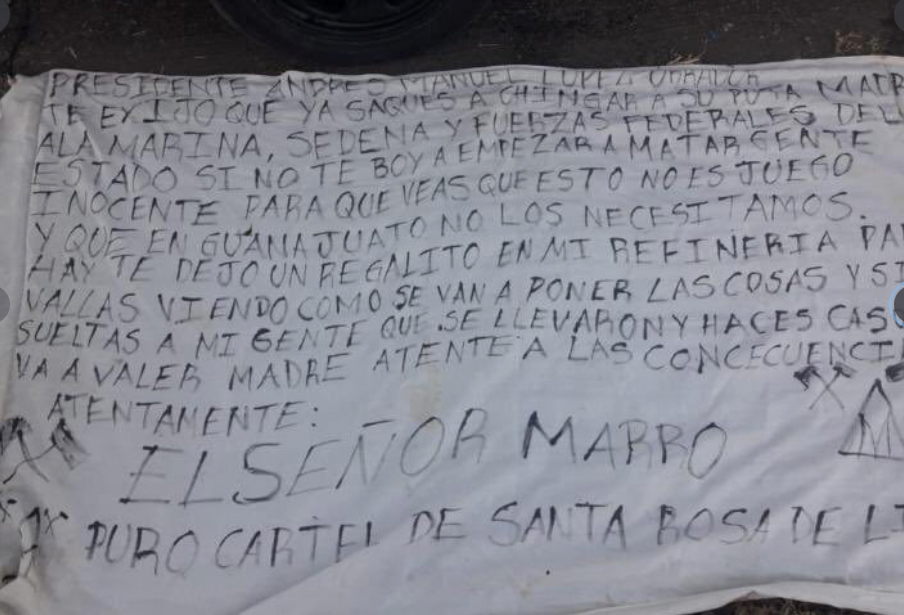
Screen shot of narcomanta communicating threat on behalf of “El Marro,” capo of the Cártel de Santa Rosa de Lima (CSRL). Source: Gobierno de México.
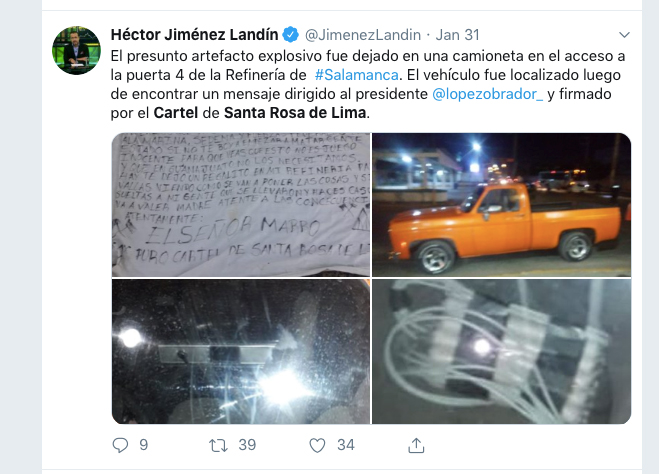
Screenshot of Twitter report by journalist Héctor Jiménez Landin containing image of incident scene, incident vehicle, explosive artifacts on interior seat, and narcomanta communicating threat on behalf of “El Marro.” Source: @JimenezLandin, 31 January 2019.
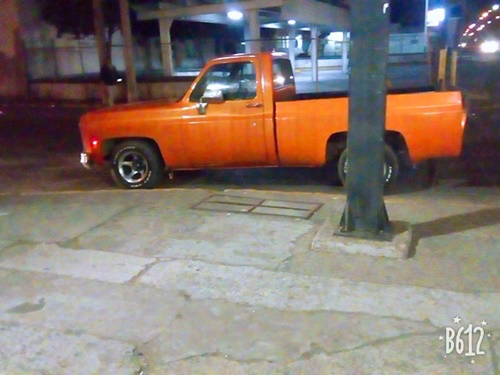
Photo of incident vehicle in front of the refinery. Source: Gobierno de México.
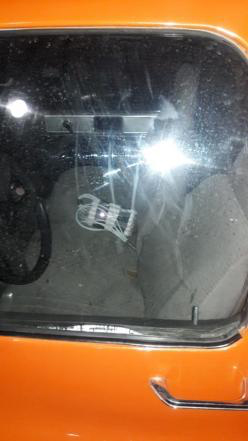
Photo of explosive artifacts on interior seat. Source: Gobierno de México.
A pickup truck with explosives (artefactos explosivos) was found on an interior seat of the vehicle. The explosive was identified as Emulex 1.[6]
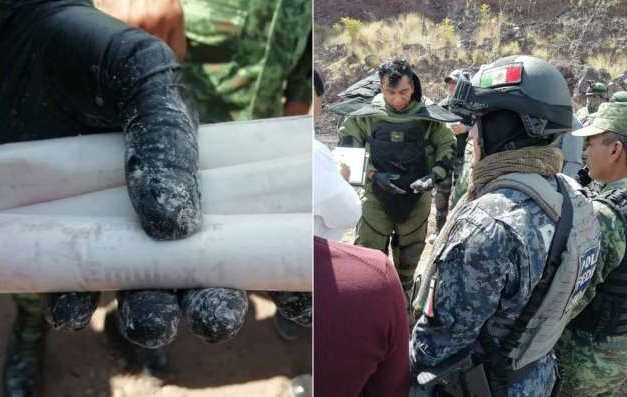
SEDENA bomb technicians identify the explosive as Emulex 1. Photos from SEDENA, Gobierno de México as reported in El Heraldo de México at http://bit.ly/2GejwFS
The threat and placement of the explosives inside the vehicle is currently attributed to the CSRL and its presumed leader José Antonio Yépez Ortiz. Known as “El Marro,” Yépez has evaded capture for the past two and a half years is now also being sought by Mexican security forces for involvement in this incident.[7] Federal security forces have been conducting detailed searches of the region including estates in town controlled by the CSRL. While these have not yet resulted in the arrest of Yépez, they have resulted in the discovery and interdiction of explosives similar to those used in the refinery incident.[8]
Explosives and Criminal Cartels
Initial reports on the Salamanca incident mentioned the vehicle containing explosives as a “coche-bomba” (car bomb)[9] yet, upon further investigation, the device was not a car bomb intended to detonate but rather a threat-vehicle—that is, a vehicle containing explosives used to communicate a threat (in this case to the President of the Republic). This incident confirms the continuing potential to employ explosives against rivals and government targets by criminal cartels seeking to defend their interests. The threat, however, needs to be placed in perspective.
While rare, car bombs have been used in Mexico.[10] Indeed, after the 15 July 2010 car bombing in Ciudad Juárez attention to this type of threat potential increased.[11] While the Cd. Juárez bombing did not involve a sophisticated device—“a primitive improvised explosive secreted inside a car not the fully-integrated variant found in Iraq, and the AfPak theatres known as a VBIED” was used—the incident targeted police.[12] In our 2013 assessment ‘Cartel Car Bombings,’ in Mexico we identified 21 car bomb (coche bomba) incidents in Mexico from 14 July 2008 to 31 July 2012.[13]
Since that review, car bomb incidents in Mexico have remained sparse. We have identified one additional incident (post-2012). This is a June 2015 incident in Cd. Juárez where Chihuahua authorities interdicted a possible car bomb described as a 2000 Volkswagen Beetle with “two sausage-shaped packages of ammonium nitrate-fuel oil, known as ANFO, in the glove compartment of the car.” The investigators claimed the explosives were sufficient to have caused a 200-foot blast radius. Four persons were arrested in connection to that explosives incident.[14] Thus, despite a cluster of car bomb incidents between 2008-2012, the trend failed to catch on.
Nevertheless, explosives use remains a salient potential in the Mexican crime wars. Bomb threats against Pemex, for example, are a constant irritant, with Pemex receiving an average of 7.5 bomb threat a year over the past 15 years.[15] These threats, unlike the explosions resulting from illicit taps (tomas clandestinas)—like that in Tlahuelilpan on 18 January 2019 which killed at least 98 persons and left 48 in hospital—are irritants.[16] Yet they signal vulnerability to ‘petro-threats’ as Mexican mayors in states are threatened by huachicoleros not to interfere with the lucrative illicit fuel trade.[17]
Confronting the State
In addition to threats against mayors and the aforementioned threats by the CSRL against ALMO,[18] the cartel’s members supporters in Guanajuato have deployed narcobloqueos (blockades) to thwart efforts to capture “El Morro” in the aftermath of the Salamanca (threat-vehicle) explosive threat.[19] These blockades come after an armed confrontation between the CSRL and CJNG that was captured on a sicario’s body-worn camera[20] and preceded a brutal attack on a bar in Salamanca (Gto) killing 15 persons.[21] These actions exemplify the threat posed by criminal cartels (narcos and huchicoleros) against Mexico’s petroleum infrastructure [22] and state institutions. They additionally make clear that the CSRL is seeking to expand its reach, and is battling both a rival cartel (the CJNG) and elements of the state (Federal security forces, along with state and municipal police) to secure their freedom of action in a classic criminal insurgent manner. This presents a strategic threat with the potential for not only increased competition and confrontation with the state but also a higher risk of violence and the prospect for renewed employment of car bombs as a means of state confrontation.[23]
Sources
“Artefacto explosivo hallado en refinería de Salamanca contenía Emulex 1, reporta Procuraduría.” El Heraldo de México. 31 January 2019, https://heraldodemexico.com.mx/estados/artefacto-explosivo-hallado-en-refineria-de-salamanca-contenia-emulex-1-reporta-procuraduria/.
“Government reveals there were explosive devices near refinery after all.” Mexico News Daily. 1 February 2019, https://mexiconewsdaily.com/news/government-reveals-there-were-explosive-devices-near-refinery/.
Mariana León, “Dejan manta contra AMLO por lucha vs. huachicoleo y falsa amenaza de bomba en refinería de Salamanca.” El Financiero. 31 January 2019, https://elfinanciero.com.mx/nacional/dejan-manta-contra-amlo-por-lucha-vs-huachicoleo-y-falsa-amenaza-de-bomba-en-refineria-de-salamanca.
“Narco-banner’s message to AMLO: remove forces or innocent people will die.” Mexico News Daily, 31 January 2019, https://mexiconewsdaily.com/news/narco-banners-message-to-amlo/.
Mariana Ramos, “Capo ‘huachicolero’ amenaza y siembra explosivo.” Milenio. 1 February 2019, https://www.milenio.com/policia/capo-huachicolero-amenaza-y-siembra-explosivo.
End Notes
[1] The turf war between the Cártel de Santa Rosa de Lima (CSRL) and Cártel Jalisco Nueva Generación (CJNG) has been heating up over the past few years as the CSRL expands its presence and illicit taps (tomas clandestinas) on the region’s fuel pipelines into areas controlled by the CJNG. See “Santa Rosa petroleum cartel expanding from Guanajuato into Querétaro, Hidalgo.” Mexico News Daily. 11 February 2019, https://mexiconewsdaily.com/news/santa-lima-petroleum-cartel-expanding/.
[2] For background on Mexico’s illicit petroleum trade, see John P. Sullivan and Adam Elkus, “Open Veins of Mexico: The Strategic Logic of Cartel Resource Extraction and Petro-Targeting.” Small Wars Journal. 3 November 2011, https://smallwarsjournal.com/jrnl/art/open-veins-mexico and Alberto Nájar, “Huachicol: cómo funcionan las redes de robo de gasolina en México.” BBC News, Mundo. 19 January 2019, https://www.bbc.com/mundo/noticias-america-latina-46818927.
[3] “La manta encontrada en la Ciudad de Salamanca, Guanajuato amenazaba al presidente por la lucha que ha implementado en su gobierno contra el robo de combustible en la República Mexicana. El mensaje indicaba que de no sacar del estado a la Marina, Sedena, Gendarmería y fuerzas federales gente inocente moriría.” See “Dejan narcomanta contra AMLO en Guanajuato, confirma Jesús Ramírez.” El Economista. 31 January 2019, https://www.eleconomista.com.mx/politica/Dejan-narcomanta-contra-AMLO-en-Guanajuato-confirma-Jesus-Ramirez-20190131-0060.html and Misael Zavala and Alberto Morales, “Hallan manta con amenaza a AMLO.” El Universal. 31 January 2019, https://www.eluniversal.com.mx/nacion/hallan-manta-con-amenaza-amlo-por-lucha-contra-huachicol.
[4] “Ahí te dejo un regalito en mi refinería.” See Mariana Cervantes, ““Empezaremos a matar inocentes”: amenazan a AMLO con narcomanta en Salamanca.” Radio Fórmula. 31 January 2019,
[5] The Salamanca Refinery is owned by Pemex Refinacion, a subsidiary of Petroleos Mexicanos (Pemex), Mexico’s national oil company. Details on the installation can be found at https://www.hydrocarbons-technology.com/projects/salamanca/.
[6] See “Artefacto explosivo hallado en refinería de Salamanca contenía Emulex 1, reporta Procuraduría.” El Heraldo de México. 31 January 2019, https://heraldodemexico.com.mx/estados/artefacto-explosivo-hallado-en-refineria-de-salamanca-contenia-emulex-1-reporta-procuraduria/. Emulex 1 is a Type E Explosive (UN Number 0241); it is a detonator sensitive emulsion widely used in mining, blasting, and construction work. See the product information brochure from Austin Powder GmbH for details http://www.austinpowder.at/EN/products/emulsion/PIB_Emulex_1_ENG_201511.pdf.
[7] “Security forces gathering intelligence on gang leader who threatened AMLO.” Mexican News Daily. 1 February 2019, https://mexiconewsdaily.com/news/security-forces-gathering-intelligence-on-gang-leader/.
[8] “Hallan explosivos en finca de huachicolero.” El Diario (Agencia Reforma). 9 March 2019, https://diario.mx/nacional/hallan-explosivos-en-finca-de-huachicolero-20190308-1487584/ and Manuel Mora MacBeath, “Operativo contra el huachicol en Guanajuato desata guerra entre CJNG y Santa Rosa de Lima.” Sin Embargo. 10 March 2019, https://www.sinembargo.mx/10-03-2019/3548544.
[9] See, for example, Moisés Mendoza, “Abandonan coche-bomba frente a Refinería de Salamanca.” Meganoticas. 31 January 2019, https://www.meganoticias.mx/cdmx/noticia/abandonan-coche-bomba-frente-a-refineria-de-salamanca/55170 and “Reportan coche bomba en refinería Salamanca; le dejan narcomensaje a Amlo.” La Opcion de Chijuahua. 31 january 2019, http://laopcion.com.mx/noticia/228014.
[10] A brief recount of notable Mexica coche bomba incidents is provided in a recent media overview by El Universal: “El día que explotó un Grand Marquis en unos XV años en Guadalajara.” El Universal. 18 January 2019, https://www.eluniversal.com.mx/nacion/seguridad/cronologia-ataques-con-conche-bomba-en-mexico.
[11] See John P. Sullivan, “Explosive Escalation? Reflections on the Car Bombing in Ciudad Juarez.” Small Wars Journal. 21 July 2010, https://smallwarsjournal.com/jrnl/art/explosive-escalation and John P. Sullivan, “¿Escalada Explosiva? Reflexiones sobre el ataque con Coche bomba en Ciudad Juárez.” Small Wars Journal. 17 July 2014, https://smallwarsjournal.com/jrnl/art/¿escalada-explosiva.
[12] Ibid. For additional discussion on the distinction between fully-developed VBIEDs (or large car bombs) see Scott Stewart, “The Perceived Car Bomb Threat in Mexico.” Stratfor, 13 April 2011, https://worldview.stratfor.com/article/perceived-car-bomb-threat-mexico.
[13] Robert J. Bunker and John P. Sullivan, Cartel Car Bombings in Mexico Carlisle Barracks: Letort Papers, U.S. Army War College. August 2013, Table 2 pp. 18-19, https://ssi.armywarcollege.edu/pdffiles/PUB1166.pdf.
[14] Lorena Figueroa, “Broken car leads to discovery of possible car bomb in Juárez.” El Paso Times, 1 July 2015, https://www.elpasotimes.com/story/news/world/juarez/2015/07/01/broken-car-leads-discovery-possible-car-bomb-juarez/71989418/ and “A car bomb was diffused in Juarez, Mexico.” War on Drugs Uncensored. 30 June 2015, http://www.cartelblog.com/a-car-bomb-was-diffused-in-juarez-mexico/.
[15] See “Amagan a Pemex con bombas más de 7 veces al año.” Vanguardia. 11 March 2019, https://vanguardia.com.mx/articulo/amagan-pemex-con-bombas-mas-de-7-veces-al-ano.
[16] “A deadly explosion in Mexico punctures the optimism of a new era.” The Economist. 23 January 2019, https://www.economist.com/the-americas/2019/01/23/a-deadly-explosion-in-mexico-punctures-the-optimism-of-a-new-era.
[17] At least 15 mayors (in the states of Jalisco, Michoacán, Guanajuato, and Querétaro) have been threatened not to interfere with petro-theft. See Pedro Villa y Caña, “”Huachioleros tienen bajo amenza a ediles.” El Universal. 27 January 2019, https://www.eluniversal.com.mx/nacion/huachicoleros-tienen-bajo-amenaza-ediles.
[18] See also Chris Dalby, “Mexico’s Santa Rosa de Lima Cartel Risks Burning Too Bright, Too Fast.” InSight Crime. 15 February 2019, https://www.insightcrime.org/news/analysis/mexicos-santa-rosa-de-lima-cartel-el-marro/.
[19] “Huachicoleros encienden Guanajuato con bloqueos.” Debate. 5 March 2019, https://www.debate.com.mx/mexico/Huachicoleros-encienden-Guanajuato-con-bloqueos--20190305-0069.html.
[20] Robert J. Bunker, Alma Keshavarz and John P. Sullivan, “Mexican Cartel Tactical Note #39: GoPro Video Social Media Posting of Cártel Santa Rosa de Lima (CSRL) Tactical Action against Cártel Jalisco Nueva Generación (CJNG) in Guanajuato - Indications & Warning (I&W) Concerns.” Small Wars Journal. 5 March 2019, https://smallwarsjournal.com/jrnl/art/mexican-cartel-tactical-note-39-gopro-video-social-media-posting-cartel-santa-rosa-de-lima.
[21] “Un grupo armado irrumpe a balazos en un bar de Salamanca (Guanajuato) en pleno operativo del Gobierno contra El Marro, líder del cartel Santa Rosa de Lima, dedicado al robo de gasolina en México” (An armed band attacked a Salamanca (Gto) bar with gunfire and killing 15 during a government crackdown on huachicoleros and manhunt for CSRL leader “El Marro”). Elena Reina, “15 asesinados en la tierra del huachicol.” El Pais. 10 March 2019, https://elpais.com/internacional/2019/03/09/mexico/1552161947_576755.html.
[22] For background on the depth of threat to Mexico’s oil infrastructure, see Gabriel Stargardter, “The Refinery Racket: Mexico’s drug cartels, now hooked on fuel, cripple the country’s refineries.” Reuters (Reuters Investigates). 24 January 2018, https://www.reuters.com/investigates/special-report/mexico-violence-oil/.
[23] For more on strategic car bomb use in Mexico by the cartels vis-à-vis “the strength of the group and the government,” see Adam L. Dulin and Jairo Patiño, “The logic of cartel car bombings in México.” Trends in Organized Crime. Vol. 17, Iss. 4. December 2014: pp. 271–289.
Additional Reading
Robert J. Bunker, Alma Keshavarz and John P. Sullivan, “Mexican Cartel Tactical Note #39: GoPro Video Social Media Posting of Cártel Santa Rosa de Lima (CSRL) Tactical Action against Cártel Jalisco Nueva Generación (CJNG) in Guanajuato - Indications & Warning (I&W) Concerns.” Small Wars Journal. 5 March 2019.
Robert J. Bunker and John P. Sullivan, “VBIEDs in the Mexican Criminal Insurgency.” The Counter Terrorist. Vol 6., No. 6. December 2013/January 2014: pp. 28-40.
Robert J. Bunker and John P. Sullivan, Cartel Car Bombings in Mexico Carlisle Barracks: Letort Papers, U.S. Army War College. August 2013.
John P. Sullivan, “Explosive Escalation? Reflections on the Car Bombing in Ciudad Juarez.” Small Wars Journal. 21 July 2010.


